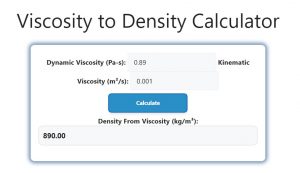About Viscosity to Density Calculator (Formula)
The Viscosity to Density Calculator is an essential tool for scientists, engineers, and anyone involved in fluid dynamics. Understanding the relationship between viscosity and density is crucial in various fields, including chemical engineering, material science, and physics. Viscosity measures a fluid’s resistance to flow, while density represents its mass per unit volume. By using this calculator, users can efficiently convert dynamic viscosity to density, facilitating accurate calculations and analyses in their projects.
Formula
The formula for calculating density from viscosity is:
Density = Dynamic Viscosity / Kinematic Viscosity
This formula provides a straightforward method for determining the density of a fluid when its dynamic and kinematic viscosities are known.
How to Use
Using the Viscosity to Density Calculator is a simple process. Follow these steps:
- Gather Data: Obtain the values for dynamic viscosity (in units like Pa·s or mPa·s) and kinematic viscosity (in units like m²/s or cSt).
- Input Values: Enter the dynamic viscosity and kinematic viscosity into the calculator.
- Calculate: Apply the formula to compute the density. The calculator will provide you with the density value, typically in kg/m³.
- Interpret Results: Use the calculated density for your specific applications, whether in laboratory settings or industrial processes.
Example
For example, if a fluid has a dynamic viscosity of 0.89 mPa·s and a kinematic viscosity of 0.001 m²/s, the calculation would be:
Density = Dynamic Viscosity / Kinematic Viscosity
Density = 0.89 / 0.001
Density = 890 kg/m³
In this case, the calculated density of the fluid is 890 kg/m³.

FAQs
- What is dynamic viscosity?
Dynamic viscosity is a measure of a fluid’s resistance to shear or flow, typically expressed in units like Pa·s or mPa·s. - What is kinematic viscosity?
Kinematic viscosity measures a fluid’s resistance to flow under the influence of gravity, often expressed in units like m²/s or centistokes (cSt). - Why is viscosity important?
Viscosity affects fluid flow behavior in various applications, including lubrication, hydraulic systems, and chemical processes. - Can I use this calculator for any fluid?
Yes, the Viscosity to Density Calculator can be used for a wide range of fluids, including liquids and gases. - What units should I use?
It’s essential to use consistent units for dynamic and kinematic viscosity, as the calculator will yield density in kg/m³. - How do I convert between viscosity units?
Use conversion factors, such as 1 mPa·s = 1 cP (centipoise) and 1 cSt = 0.001 m²/s, to ensure consistency in your calculations. - Can this calculator be used in chemical engineering?
Yes, it is particularly useful in chemical engineering for designing processes and analyzing fluid behavior. - How does temperature affect viscosity and density?
Temperature changes can significantly impact both viscosity and density, so it’s important to consider the temperature at which measurements are taken. - Is this calculator suitable for food processing applications?
Yes, the Viscosity to Density Calculator can be used in food processing to ensure product consistency and quality. - What is the relationship between viscosity and density?
Viscosity and density are interrelated properties; changes in one can affect the other, particularly in non-Newtonian fluids. - How can I measure viscosity?
Viscosity can be measured using devices like viscometers or rheometers. - What types of fluids are considered Newtonian?
Newtonian fluids have a constant viscosity regardless of shear rate, such as water and air. - What are non-Newtonian fluids?
Non-Newtonian fluids exhibit a change in viscosity when subjected to shear stress, such as ketchup and blood. - Can I use this calculator for industrial applications?
Yes, it is widely applicable in industries like oil and gas, pharmaceuticals, and manufacturing. - What should I do if I have a mixture of fluids?
For mixtures, it’s best to measure the viscosity and density of the mixture directly rather than using individual components. - Is the calculator accurate?
The accuracy depends on the quality of the input data (viscosity values). Always ensure accurate measurements. - What is the significance of knowing density?
Density is vital for understanding fluid behavior, flow rates, and material properties in various applications. - How often should viscosity and density be measured?
Regular measurement is important in processes where fluid properties can change, such as during production or storage. - What software can assist with these calculations?
Many fluid dynamics simulation tools and software can assist in calculating viscosity and density for complex systems. - Where can I find additional resources on fluid properties?
Scientific journals, textbooks on fluid mechanics, and industry standards are excellent resources for further learning.
Conclusion
The Viscosity to Density Calculator is a powerful and user-friendly tool that simplifies the conversion of dynamic viscosity to density. Understanding these fluid properties is essential for various scientific and industrial applications, enabling professionals to make informed decisions and optimize processes. By utilizing this calculator, you can ensure accuracy in your fluid analyses, leading to better results in your projects. Whether you’re a student, engineer, or researcher, mastering the relationship between viscosity and density will enhance your understanding of fluid dynamics.